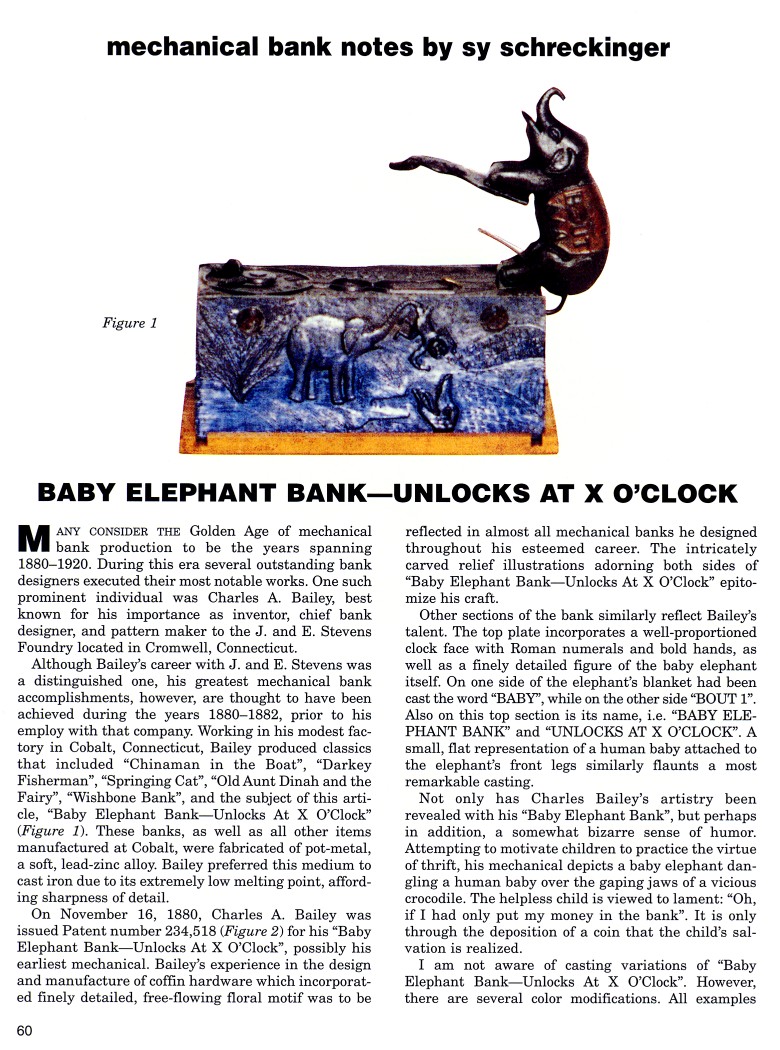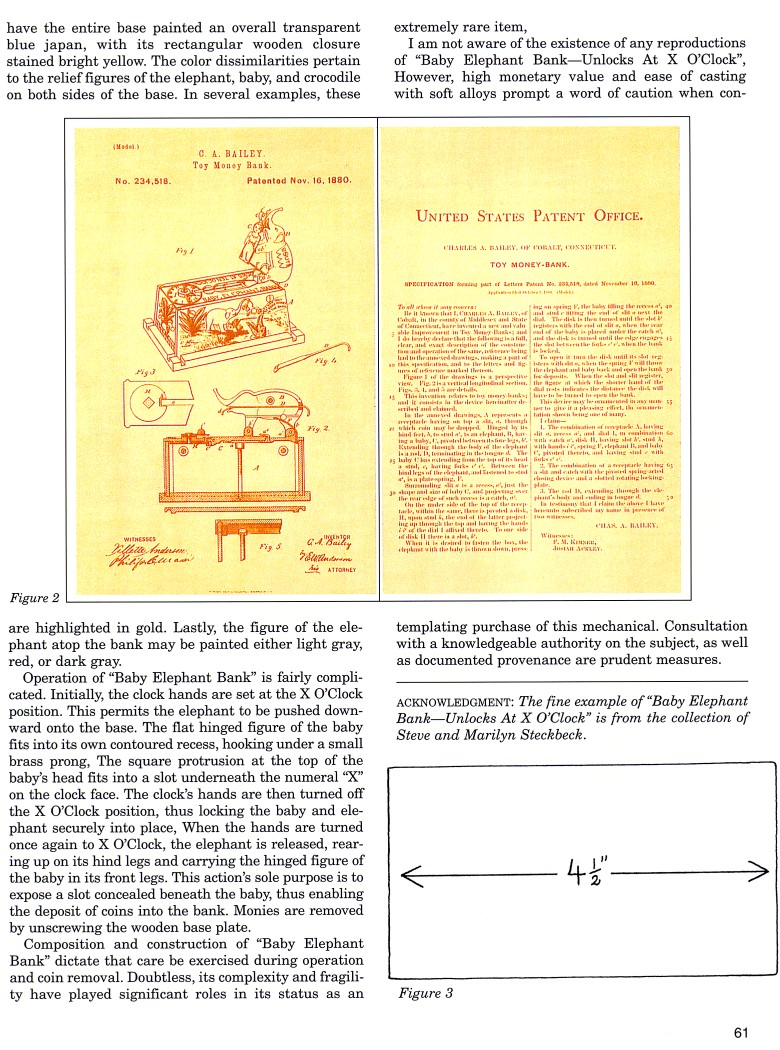|
Baby Elephant — Unlocks at X O'Clock
by Sy Schreckinger – ANTIQUE TOY WORLD Magazine – March, 1999
Many consider the Golden Age of mechanical
bank production to be the years spanning 1880-1920. During this era
several outstanding bank designers executed their most notable works. One
such prominent individual was Charles A. Bailey, best known for his
importance as inventor, chief bank designer, and pattern maker to the J.
and E. Stevens Foundry located in Cromwell, Connecticut.
Although Bailey's career with J. and E. Stevens was a distinguished
one, his greatest mechanical bank accomplishments, however, are thought to
have been achieved during the years 1880-1882, prior to his employ with
that company. Working in his modest factory in Cobalt, Connecticut, Bailey
produced classics that included "Chinaman in the Boat", "Darkey
Fisherman", "Springing Cat", "Old Aunt Dinah and the Fairy", "Wishbone
Bank", and the subject of this article, "Baby Elephant Bank — Unlocks At X O'Clock" (Figure 1). These banks, as well as all other items manufactured
at Cobalt, were fabricated of pot-metal, a soft, lead-zinc alloy. Bailey
preferred this medium to cast iron due to its extremely low melting point,
affording sharpness of detail.
On November 16, 1880, Charles A. Bailey was issued Patent number
234,518 (Figure 2) for his "Baby Elephant Bank — Unlocks At X O'Clock",
possibly his earliest mechanical. Bailey's experience in the design and
manufacture of coffin hardware which incorporated finely detailed,
free-flowing floral motif was to be reflected in almost all mechanical
banks he designed throughout his esteemed career. The intricately carved
relief illustrations adorning both sides of "Baby Elephant Bank — Unlocks At
X O'Clock" epitomize his craft.
Other sections of the bank similarly reflect Bailey's talent. The top
plate incorporates a well-proportioned clock face with Roman numerals and
bold hands, as well as a finely detailed figure of the baby elephant
itself. On one side of the elephant's blanket had been cast the word
"BABY", while on the other side "BOUT 1". Also on this top section is its
name, i.e. "BABY ELEPHANT BANK" and "UNLOCKS AT X O'CLOCK". A small, flat
representation of a human baby attached to the elephant's front legs
similarly flaunts a most remarkable casting.
Not only has Charles Bailey's artistry been revealed with his "Baby
Elephant Bank", but perhaps in addition, a somewhat bizarre sense of
humor. Attempting to motivate children to practice the virtue of thrift,
his mechanical depicts a baby elephant dangling a human baby over the
gaping jaws of a vicious crocodile. The helpless child is viewed to
lament: "Oh, if I had only put my money in the bank". It is only through
the deposition of a coin that the child's salvation is realized.
I am not aware of casting variations of "Baby Elephant Bank — Unlocks
At X O'Clock". However, there are several color modifications. All
examples have the entire base painted an overall transparent blue japan,
with its rectangular wooden closure stained bright yellow. The color
dissimilarities pertain to the relief figures of the elephant, baby, and
crocodile on both sides of the base. In several examples, these are
highlighted in gold. Lastly, the figure of the elephant atop the bank may
be painted either light gray, red, or dark gray.
Operation of "Baby Elephant Bank" is fairly complicated. Initially,
the clock hands are set at the X O'Clock position. This permits the
elephant to be pushed downward onto the base. The flat hinged figure of
the baby fits into its own contoured recess, hooking under a small brass
prong, The square protrusion at the top of the baby's head fits into a
slot underneath the numeral "X" on the clock face. The clock's hands are
then turned off the X O'Clock position, thus locking the baby and elephant
securely into place, When the hands are turned once again to X O'Clock,
the elephant is released, rearing up on its hind legs and carrying the
hinged figure of the baby in its front legs. This action's sole purpose is
to expose a slot concealed beneath the baby, thus enabling the deposit of
coins into the bank. Monies are removed by unscrewing the wooden base
plate.
Composition and construction of "Baby Elephant Bank" dictate that
care be exercised during operation and coin removal. Doubtless, its
complexity and fragility have played significant roles in its status as an
extremely rare item.
I am not aware of the existence of any reproductions of "Baby
Elephant Bank — Unlocks At X O'Clock", However, high monetary value and ease
of casting with soft alloys prompt a word of caution when contemplating
purchase of this mechanical. Consultation with a knowledgeable authority
on the subject, as well as documented provenance are prudent measures.
ACKNOWLEDGMENT: The fine example of "Baby Elephant Bank—Unlocks At X
O'Clock" is from the collection of Steve and Marilyn Steckbeck.
|


